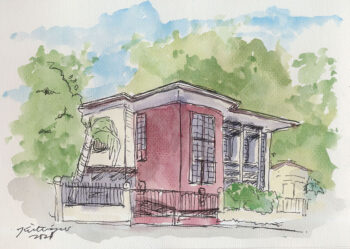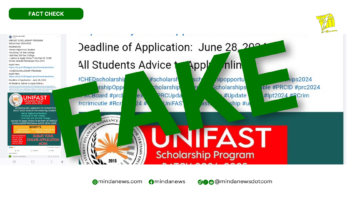
DAVAO CITY (MindaNews / 20 September) – There are many reasons why the Davao City Council should be hesitant about putting its support behind the Waste-to-Energy (WtE) incineration project.
There are very serious concerns about the health hazards of the project which have been eloquently expressed by different parties of concerned citizens. The present analysis focuses on what we can learn from a more careful review of the feasibility study made of the project.
The study was made in 2020 by a consortium of three Japanese consultancy agencies: KPMG AZSA LLC, Yachiyo Engineering Co. Ltd. and EX Research Institute Ltd. The feasibility study was made for the Department of Finance and the City Government of Davao (CGD) and supported by Government of Japan Overseas Development Assistance. The three consultancy agencies have had long-standing relations with the Japanese government which also influences the way they look at the project.
A “sanitary treatment” business not a power generation business
The feasibility study outright states that “the electricity generating business is not the primary purpose of the WtE project” (p. 69). In other words, the “waste-to-energy” label is clearly a misnomer of the project. Indeed, the feasibility study makes abundantly clear that the project is about incineration first, meaning, burning the waste but not about generating the electricity that is supposed to be a result of the burning.
The same is conveyed on page 126 of the report where it says: “It is understood that when the project was formulated the Government of the Philippines and the Government of Japan recognized that the project will be a sanitary treatment business of the MSW (Municipal Solid Waste) rather than a power generation business.” Meaning, burning the waste with doubtful benefits in electricity generation.
So why keep on referring to the project as an energy generation project which is implied in calling it a Waste-to-Energy project? Clearly a case where the flag doesn’t cover the load or where the label doesn’t correspond with the reality.
Tipping fees
A very important aspect of the project is the expensive tipping fees which in the long run are likely to be a very burdensome cost item for Davao City.
Tipping fees or gate fees are the payment that the company that will run the WtE incinerator project will charge to burn the waste delivered to the WtE incinerator plant. This fee is based on the weight of the waste and is charged per ton (1,000 kilograms).
Tipping fees can be passed on to actual waste generators, for instance to individual barangays or commercial establishments or companies that would want to dispose of their waste through the WtE incinerator.
The feasibility study makes clear the tipping fees will have to be paid by the Davao City Government.
If in the course of the project the tipping fees will turn out not to be enough to finance the maintenance and other operating costs of the plant, the feasibility study makes clear that the City of Davao Government will have to pay more to keep the project “sustainable.”
How much will be the tipping fee in the planned WtE incineration project?
Originally the tipping fee was set at P600 per ton. The feasibility study however says (on page 116) that “the Project has no profitability in the case that the (…) tipping fee is P600 per ton. A tipping fee of more than P3,000/ton is necessary for the project to be viable.”
In other words, the tipping fee needs to be at least five times more than originally conceptualized. And this revised amount roughly refers to the period before the COVID pandemic. Analysts estimate that the required tipping fees will even be higher in this post-COVID period, especially after the eventual construction of the facility which will take another three more years.
As stated in the feasibility study, the Government of Davao City will have the duty to pay the tipping fees to the Special Purpose Company (SPC) of Japan that is expected to be set up by Japan to run the project.
The SPC won’t run any risk in case the tipping fees are insufficient. As the feasibility study states: “Additional budget or subsidy shall be allocated by City Government of Davao to the SPC/Service Provider for the operation of the facilities to be financially sustainable.”
The feasibility study submits that the SPC/Service Provider may be 100% owned by foreign investors (including Japanese nationals and investors), meaning, “Japanese physical persons or Japanese juridical persons controlled by Japanese physical persons and registered in Japan.”
Lifespan of the project
The feasibility study indicates that the lifespan of the WtE incinerator is (only) 20 years, and “demolishment of facilities” is the next normal course of action (Page 94).
The argument is that “WtE facilities in Japan adopt 20 years as their Operations and Maintenance (O&M) period because the core component of WtE incinerators requires a large overhaul and additional Capital Expenditures in the cycle of 20 years. If a period is longer than 20 years, the costs for the Service Provider significantly increase.”
In addition, the feasibility study states that “In case the facilities are demolished, it is a general norm that a party who has an ownership over the facility shall assume the costs of the demolishment.” It is an indirect way of saying that the CGD will have to foot the bill for the “demolishment.”
In the feasibility study a continuous operation of the WtE incinerator is considered as a possibility beyond the first 20 years. In that case the CGD will have to manage the operational and maintenance costs of facilities that by industry standards are likely to be in less than optimal conditions.
But as a clincher the feasibility study also states that demolishment of the facility rather than continuation is “more likely to be applied.”
Apparently the idea of continuation is not really seen as a real option but only brought up to pre-empt arguments of the long-term unsustainability of the project.
It means that financially speaking, an expensive incineration project with a limited time span with very high operational, maintenance, and capital expenditure must be weighed against a very long-term recycling approach. In the first case the waste really goes up in smoke, while in the second case the waste leads to long-term and community based job and income generation without the generation of Green House Gases and more waste. Having the waste burned will require payment (tipping fees) whether or not it leads to electricity generation.
What is needed in the long-term is more creative and long-term thinking and political will and commitment for real sustainable waste management solutions. The easy and lazy and polluting solution is the burning solution.
Costs
In 2018, the Japan Government promised grant assistance, or a donation, amounting to around P2.5 billion at today’s exchange rate to partially fund the “Project for the Construction of Waste-to-Energy Facilities in Davao City.”
Construction is one thing. What are the other costs for this very centralized processing of letting waste go up in smoke?
The average OPEX (operating expenses) per year is PhP295 million as an average for 20 years operation. This boils down to an average of Php24 million per month.
According to the feasibility study, the yearly repair cost is assumed to be in the range of PhP114 million/year to PhP172 million/year. On the average, it will be PhP145 million per year or Php12 million per month.
In other words, the running costs and the repair costs are huge.
The Davao City Council’s resolution requests for a Php3.486-billion counterpart fund from the national government “for the continuity of the project.” This is meant to mean that the DCG will use this money to pay for the tipping fees of the project.
Waste volume, waste quality
For the duration of the WtE incineration project, the City Government of Davao has to guarantee (1) a certain volume of waste and (2) a certain quality of waste to the Special Purpose Company/Service Provider.
It means that the burden of guaranteeing a certain volume of waste to be incinerated is passed on to the City Government of Davao and is not a responsibility of the Special Purpose Company that will be set up. The same applies to the quality of waste to be delivered: Davao City has to make sure that the calorific value or the combustible potential of the waste is guaranteed. If not, Davao City will have to pay compensation.
Both the required minimum volume and quality of combustible waste are provisions typical for incineration projects that rely on and require the ongoing production of waste. These provisions even lead to the unnecessary production of combustible waste, unlike a zero waste or recycling approach which aims for minimal levels of waste production and maximum levels of recycling.
With the CENRO’s budget for waste management in Davao City amounting to around P300 million per year, priorities can and need to be set in terms of appropriate solid waste recycling facilities and composting facilities.
Electricity sales
The feasibility study posits that the Special Purpose Company that will manage the facilities shall have “the right to market and sell all capacity (energy) generated by the project facilities from the conversion of Waste to Energy.” The study also states that “all revenues derived from the sale of electricity generated by the project facilities shall accrue solely to the SPC.”
It means that the tipping fees are substantial and guaranteed while the income from the sale of energy is to the sole benefit of the SPC.
In other words, a likely Japanese company or entity (the SPC) is going to run the facilities without any risk of loss while also benefiting solely from any electricity sale.
So what is, really, in all of this, beneficial for Davao City?
(Arnold Vandenbroeck, originally from Belgium, came to the Philippines as a community development worker and church worker in 1974, two years after martial law was declared. He spent five years in Agusan in the early 1980s and after People Power in 1986, spent eight years in Antique. In 2011, he was knighted by the King of Belgium in the “Order of the Crown” in recognition and appreciation of his development work and engagements. He has been based in Davao City since the late 1990s where he set up the Interfacing Development Interventions for Sustainability (IDIS Inc.), an environmental advocacy organization focused on influencing policies and practices of local government units, people’s organizations and non-governmental organizations. He continues to be actively involved in watershed protection in the Davao uplands.)







